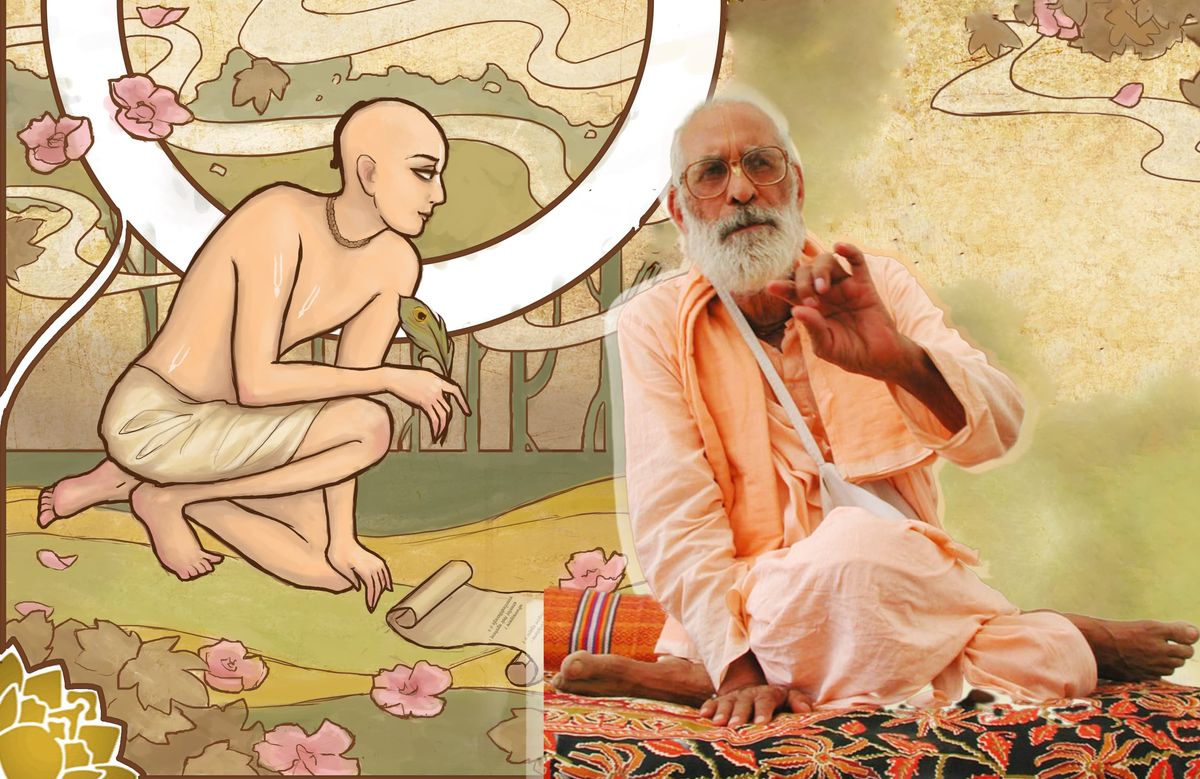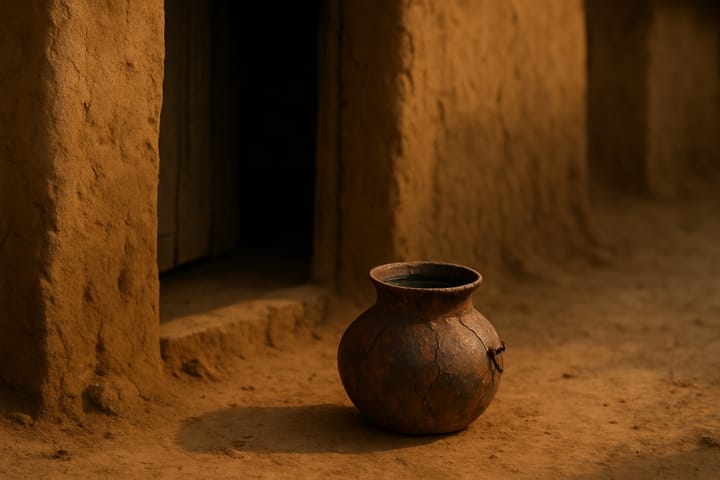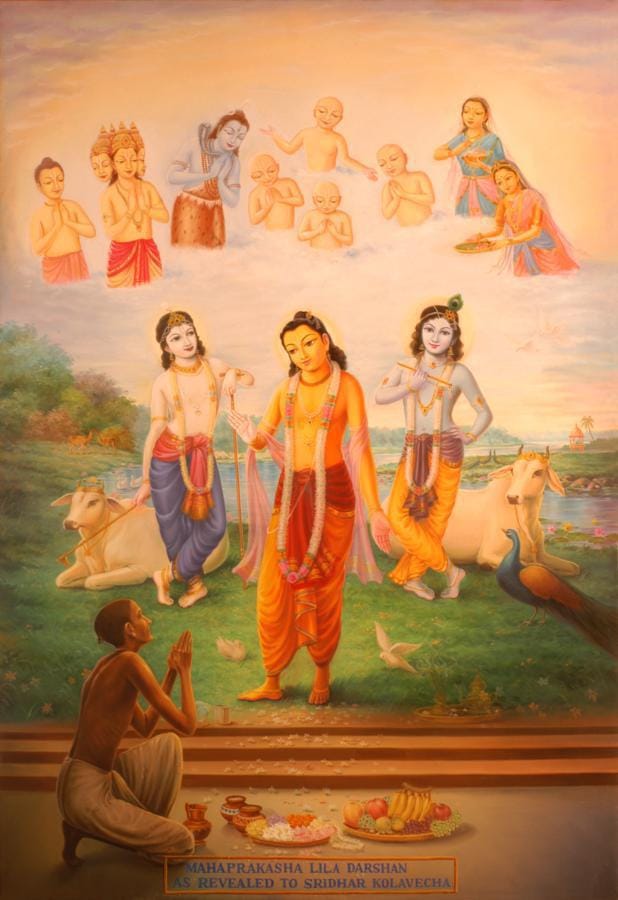Śrīla Gurudeva's Rūpānugatva and the Meaning of Rūpānuga

Tomorrow's Pavitrāropaṇa Ekādaśī marks the beginning of Śrī Śrī Rādhā-Govinda's five-day Jhūlana-yātrā festival—celebrated throughout Vraja and the entire world by devotees of various sampradāyas. After that comes the day, which, for us in our line, is probably the most significant occasion in the entire year: the commemoration of Śrīla Rūpa Gosvāmī's disappearance.
Within our rūpānuga lineage, an individual's eminence is measured by their rūpānugatva — the degree to which they follow in the footsteps of Śrīla Rūpa Gosvāmī — and their fearless, authentic propagation of the rūpānuga conception.
Śrīla Gurudeva's rūpānugatva
The unique rūpānugatva of my Śrīla Gurudeva, Śrīla Bhaktivedānta Nārāyaṇa Gosvāmī Mahārāja, was evident to all who came into his presence. Yet, during this Jhūlana season, a particular sense of pride would envelop Śrīla Gurudeva's followers, as his rūpānugatva would radiate with exceptional brilliance.
I have never heard of any other place or person across the globe that orchestrated such a rasa-filled three-day festival to commemorate and disseminate the glories of Śrīla Rūpa Gosvāmī, like the one arranged by my worshipable Gurudeva at Śrī Rūpa Sanātana Gauḍīya Maṭha in Vrindavan each year. Word of this festival would spread far and wide; advertisements for it were even broadcast on the local television stations. Eminent scholars of Vraja, the local residents of Mathura and Vrindavan, brahmacārīs and sannyāsīs from various Gauḍīya Maṭhas, respected devotees from ISKCON, and followers of various sampradāyas would all assemble for this occasion. People would travel from all corners of the globe to partake in the unique nectar imparted by Śrīla Gurudeva and other esteemed Vaiṣṇavas during this period.
Even when his health was poor, he would sit for three-hour stretches, enduring considerable discomfort to instill the concepts of Śrīla Rūpa Gosvāmī and to kindle within every heart the fervent desire to tread the path of the rūpānugas.
What is rūpānuga?
Something Śrīla Gurudeva used to emphasize over and over was the meaning of the term "rūpānuga". People commonly believe that anyone who follows the moods of any of the residents of Vraja, as delineated in Śrīla Rūpā Gosvāmī's Śrī Bhakti-rasāmṛta-sindhu, qualifies as a rūpānuga. In this view, the distinction between rūpānuga and rāgānuga becomes somewhat blurred. Śrīla Gurudeva, however, taught us that in the deepest and truest sense, a rūpānuga is one who wholeheartedly follows Śrī Rūpa in the external world as Śrīla Rūpa Gosvāmī and internally as Śrī Rūpa Mañjarī. The teachings and supplications of our guru-varga unanimously underscore this alone to be the ultimate aspiration.
In conclusion, I am sharing an excerpt on this topic from a small booklet that Śrīla Gurudeva wrote on the occasion of the divine departure of Śrīla Bhakti Jīvana Janārdana Gosvāmī Mahārāja—an esteemed disciple of Śrīla Bhaktisiddhānta Sarasvatī Gosvāmī Prabhupāda:
Rāgānugā and Rūpānugā
One day, he [Śrīla Bhakti Jīvana Janārdana Mahārāja] very affectionately said to me, “Tell me, tell me, what is śrī rāgānugā and śrī rūpānugā? Are they the same or does each contain a speciality? I have asked many Vaiṣṇavas, but I was not fully satisfied by their answers.”
When I heard his question, at first I felt somewhat hesitant to give an answer before someone so well-versed in siddhānta. However, at his repeated insistence and upon pūjyapāda Vāmana Mahārāja’s indication, I, like a student under examination, said, “According to what I have heard from śrī guru and Vaiṣṇavas and from what I have understood from continuous study of bhakti-śāstras, my firm conviction is that if those who develop a greed to attain the beauty of the services and moods of the eternally perfect associates in dāsya-, sakhya-, vātsalya-, and madhura-rasa, as described in the rasa-śāstras Śrī Bhakti-rasāmṛta-sindhu and Ujjvala-nīlamaṇi, and perform sādhana-bhajana following the eternally perfect moods (nitya-siddha-bhāva) [of one of those associates] out of longing to attain the beauty of those services and moods, they are called rāgānugā-sādhakas.
“However, those who have developed a greed to follow in the footsteps of Śrīla Rūpa Gosvāmī – his innate form (svarūpa) engaged in serving Rādhā and Kṛṣṇa and accordingly, his eternally perfect and meticulous skill in performing yugala-sevā, his greater affection for Śrī Rādhā (śrī rādhā-snehādhikā-bhāva), as well his other moods – and out of an ardent longing to attain the above-stated moods perform sādhana-bhajana accordingly – they alone are rūpānuga-sādhakas. As an associate of Śrī Gaura, Śrīla Rūpa Gosvāmī has performed sādhana-bhajana in his form as a sādhaka, and in his pure, spiritual form (śuddha-śarīra) as Rūpa Mañjarī, he serves Śrīmatī Rādhikā in partiality to Her. Only those who follow Śrī Rūpa in this way, in both of these moods, are rūpānugā. There is a special consideration in this regard: every rūpānugā is rāgānugā, but not every rāgānugā is rūpānugā.”
Hearing this, pūjyapāda Mahārāja became overwhelmed with emotion and said, “Today, I have become extremely delighted to hear your deliberation on this. It is what I wanted to hear. Prior to this, no one has so clearly presented to me such a fully perfect and conclusive discernment [on this topic].”
Translated by the Rays of The Harmonist team
from the booklet entitled Viraha-smāraka-prakāśana
by Śrī Śrīmad Bhaktivedānta Nārāyaṇa Gosvāmī Mahārāja
(Link to the original article)



Comments ()